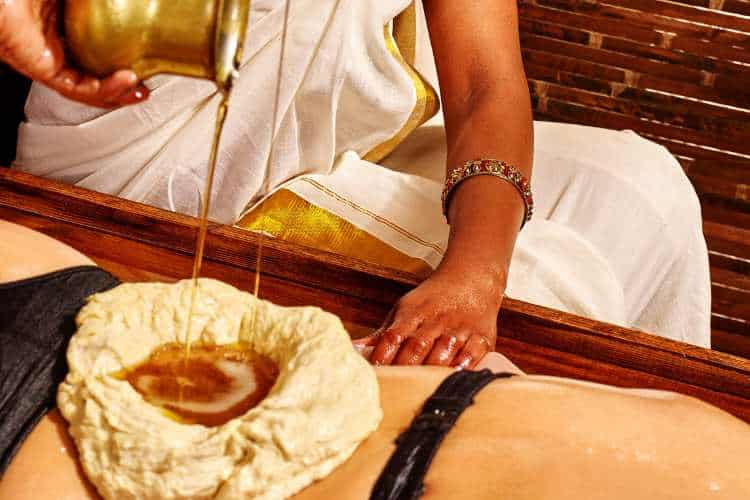Vasti -Ayurvedic Treatment
Vasti Ayurvedic Treatment in Coimbatore
Vasti is considered the corner stone of treatment or the half treatment in Ayurveda and an integral component of the Panchakarma therapies. It involves administering medicated liquids into the colon through the rectum using a specially designed instrument. Vasti is considered the best treatment for Vata dosha, which governs movement, nervous system functions, and elimination.

Pure Herbal

Evidence Based

Guranteed Results
Book Vasti Ayurvedic Treatment in Coimbatore.
If you are looking for Vast Ayurvedic Treatment in Coimbatre Book an appointment and get free consultation.
Ayurvedic Perspective on Disease
Ayurveda views Vata dosha as the prime culprit for causing diseases, and vasti helps to balance Vata and remove toxins from the lower part of the body. It is useful for a wide range of health issues, especially those related to the digestive system, joints, nerves, and chronic constipation.
There are two main types of Vasti:
- Nirooha Vasti (Decoction-based / Kashaya Vasti): Cleansing in nature
Anuvasana Vasti (Oil-based / Sneha Vasti): Nourishing and lubricating
What is Vasti?
Vasti is a therapeutic enema given using herbal oils or decoctions. It is not like modern enemas used for bowel emptying. Instead, Ayurvedic Vasti is used to detoxify, nourish, and heal the entire system, especially the colon. It is done using a special tool called Vasti netra, which is connected to a soft bag (Putaka) that holds the medicine. There are two major types of vasti; these two types are often used in combination, depending on the patient’s condition and the treatment plan.
- Nirooha Vasti is given using herbal decoctions and is mainly for purification.
- Anuvasana Vasti is done using medicated oils or ghee and is mainly for nourishment.

Who is Eligible for Vasti?
Vasti is a powerful therapy, but it is not suitable for everyone. An Ayurvedic doctor will assess your body type, strength, digestive power, and current health condition before advising this treatment.
Suitable for people with:
- Vata-related disorders like joint pain, sciatica, and constipation
- Neurological disorders
- Chronic fatigue and weakness
- Infertility
- Dry skin, bloating, and gas
- Arthritis and osteoporosis
- Lower back pain, paralysis, and insomnia
Not suitable for:
- Very weak or emaciated individuals
- People with severe diarrhoea or bleeding disorders
- Pregnant women (in most cases)
- Acute fevers, infections, or indigestion
- Children and the elderly without proper strength
Which Diseases are Treated by Vasti?
Vasti is one of the most versatile Ayurvedic therapies and can help manage many conditions:
- Rheumatoid arthritis (Amavata)
- Sciatica (Gridhrasi)
- Constipation (Vibandha)
- Paralysis (Pakshaghata)
- Irritable bowel syndrome (Grahani)
- Gout (Vatarakta)
- Menstrual problems
- Infertility and sperm disorders
- Neurological weakness
- Lower back pain, disc issues
Vasti helps by removing toxins, balancing Vata, and nourishing the tissues.
How to Prepare the Patient for Vasti
For Nirooha Vasti (Cleansing type):
- Vasti is usually done in the late morning, around 10 to 11 am, when digestion is moderate and body strength is good.
- The patient should be on an empty stomach or may take a very light meal early in the morning if they are weak.
- A full body oil massage (Abhyanga) followed by steam therapy (Swedana) is done before the procedure to loosen toxins and increase the effectiveness.Procedure of Nirooha Vasti
Patient Position
- The patient lies down on a knee-high cot in left lateral position (on the left side).
- The left leg is kept straight, and the right leg is bent at the hip and knee.
- The left arm is placed under the head for support.
Steps of Administration
- A small amount of plain ghee or medicated oil is applied to the anus and the tip of the Vasti netra for easy insertion.
- Wearing sterile gloves, the doctor performs a rectal examination to ensure the rectum is not blocked with stool or any other obstruction.
- The Vasti netra is held in the left hand and the putaka (bag with medicine) in the right.
- Air is removed from the instrument, and the Vasti netra is gently inserted into the rectum.
- The medicine (decoction) is slowly and steadily pushed into the colon.
- The patient is asked to breathe deeply and count to ten to stay calm.
- After insertion, a small portion of the medicine is left in the bag to prevent air from entering.
- If the patient feels the urge to pass stool during the process, the Vasti netra is removed, and the patient is allowed to clear the bowels. Any remaining medicine can be given afterwards.
Post-Procedure Care (Paschatkarma)
- The patient is advised to lie in a supine position (on the back) until they feel the urge to pass stools.
- He/she can go to the toilet as many times as needed.
- After passing stools, the patient should take a warm water bath.
- A light meal suitable for their dosha is given, such as rice with moong dal soup (Mudgayoosha) or meat soup (Mamsarasa) if indicated.
- Vital signs like blood pressure, pulse, retention time, and number of evacuations are recorded.
- The patient is advised to rest, stay warm, and eat only light food for the rest of the day.
Complications of Nirooha Vasti
- Abdominal discomfort or pain: Managed with mild herbs like Deepana (digestive stimulants), Anulomana (carminatives), and warm fomentation.
- Immediate evacuation without retention: Another Vasti may be given with a lower dose and less salt.
- Sphincter weakness or loss of control: The patient should be calmed. Foot-end elevation, hot drinks, and warming the body may help. Medications like Salabanaladi kashaya, Dhanwantharam Gulika, and Drakshadi kashaya are used.
- Vomiting: Usually settles on its own. Chandrakala rasa, Drakshadi Kashaya, Dhanwantharam Gulika can be used.
- Allergic reaction. If skin itching, rashes, or breathing difficulty occur, Haridrakhandam, Trikatu with sugar, Chandanasava, and Draksharishta may be given.
- Long retention: Blockages due to piles, faeces, or prostate should be ruled out. A rubber tube or rectal suppository (Gudavarthi) may be used to help evacuate.
Anuvasana Vasti (Oil-Based Vasti)
Anuvasana Vasti is a nourishing treatment done with medicated oil or ghee. It is used:
- As part of a larger Vasti treatment plan (e.g., Yoga Vasti, Karma Vasti)
- Alone in small doses (Matra Vasti)
- In chronic Vata conditions, where cleansing is not suitable
This type of Vasti does not cause strong purging, and the oil gets absorbed, lubricates the intestines, and nourishes body tissues.
Procedure of Anuvasana Vasti
Time of Administration
- Usually done after lunch, between 1 to 2 pm, when the digestive fire is strong.
Preoperative Steps
- The patient is given food, then asked to walk a short distance to promote digestion.
- The patient is asked to lie in the left lateral position: right leg bent, left leg straight, and left hand under the head.
- The medicated oil or ghee (Snehadravya) is gently warmed.
Steps of Administration
- Wearing gloves, the doctor does a rectal exam to check for blockages.
- The warmed oil is filled in a container and attached to the Vasti netra.
- The instrument is inserted gently into the anal canal, pointing toward the spine.
- The oil is pushed in slowly and evenly: not too fast, not too slow.
- A small amount of oil is left in the container to avoid air bubbles.
- The Vasti netra is removed carefully.
Post-Procedure Care
- The patient lies on his back (supine position).
- A mild abdominal massage is done.
- The patient bends his knees and gently hits his buttocks with heels (this helps the oil to move in).
- He is advised to rest with a pillow under his thighs.
- The urge to pass motion is allowed naturally.
- Warm water is used for cleaning and bathing.
- Until the oil is expelled, no food is allowed.
- Usually, the oil comes out mixed with stool within 1 to 5 hours.
Complications and Management in Anuvasana Vasti
- Abdominal pain or bloating: Hinguvachadi or Vaiswanara choorna can help relieve symptoms.
- Delayed expulsion: A gentle enema or suppository may be given if the oil doesn’t come out.
Dos and Don’ts
Do:
- Follow your physician’s instructions carefully.
- Eat only the prescribed light diet before and after the procedure.
- Stay calm and relaxed during and after the treatment.
- Take complete rest on the day of Vasti.
- Report any unusual discomfort to your doctor.
Don’t:
- Avoid heavy food, cold drinks, and hard physical activity on the day of treatment.
- Do not sleep during the day or stay up late at night.
- Avoid travel, stress, and exposure to wind or cold.
- Do not force yourself to pass motion if the urge hasn’t come.
Conclusion
Vasti holds a distinct position in the world of Ayurveda when compared to other treatment modalities, due to its wide spectrum and competent benefits. Vasti Karma controls Vata dosha at its root, and thus, all metabolic processes under the control of Vata are automatically regulated as if the root of the diseased tree is destroyed; its branches, leaves, and flowers are automatically destroyed. No other treatments are as capable as vasti to tolerate and regulate the force of Vata. Thus, Vasti has promotive, curative, preventive, and rejuvenative effects.
What are you waiting for...
Book an Appointment
Hours & Contact
28A Bharathi Park 7th Cross, Saibaba Colony, Coimbatore
641043
+9142229 69555
+9189039 69555
info@avanikaayurvedic.com
Open All Days 7:00 AM -7:00 PM
